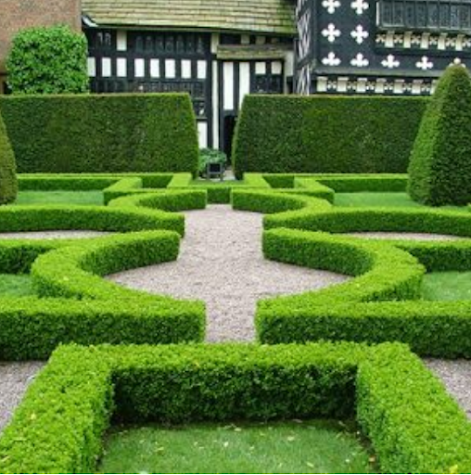The Art and History of Knot Gardens: A Guide to Creating Your Own
Introduction
Knot gardens are a testament to the artistry and precision of traditional European gardening. With their intricate patterns and lush greenery, these gardens have captivated gardeners and landscape enthusiasts for centuries. Originating in the 16th century, knot gardens remain a popular choice for those looking to infuse their outdoor space with a sense of history, order, and elegance.
In this blog, we’ll explore the history of knot gardens, their key elements, and how you can create one in your own garden.
History of Knot Gardens
Knot gardens first emerged during the Renaissance, a period that celebrated symmetry, order, and classical beauty. These gardens were particularly popular in England and France, where they adorned the estates of the nobility. Inspired by the intricate designs of embroidery and tapestry, knot gardens were meticulously laid out to create interwoven patterns, often resembling Celtic knots or other geometric designs.
The name "knot garden" comes from the way the plants are arranged to create the illusion of interwoven threads or ropes, much like a decorative knot. Early knot gardens were typically made up of low-growing herbs like thyme, rosemary, and lavender, which were pruned and maintained to form the elaborate designs. Over time, these herbs were often replaced with evergreen shrubs such as boxwood (Buxus sempervirens) to create a more permanent structure.
Key Elements of Knot Gardens
The defining feature of a knot garden is its intricate design. The layout is usually geometric, with patterns that interlace to form a symmetrical design. These patterns are typically enclosed within a square or rectangular border, adding to the sense of order and precision. While the traditional knot garden features intricate, interwoven patterns, more modern interpretations may include simpler designs that still capture the essence of the original concept.
Low-growing, tightly clipped plants are essential for creating the clean lines and sharp edges that define a knot garden. Boxwood is a popular choice due to its dense growth and ability to be shaped easily. However, other plants like dwarf lavender, thyme, or santolina can also be used to add texture, fragrance, and color to the garden.
In addition to the structured greenery, many knot gardens incorporate gravel or colored stones to highlight the design. The paths between the plants may be filled with these materials to create contrast and ensure that the pattern is easily visible. Some gardens also feature a central focal point, such as a statue, sundial, or ornamental urn, to draw the eye and anchor the design.
Creating Your Own Knot Garden
Designing a knot garden requires careful planning and attention to detail, but the results can be stunning. To start, choose a location that receives plenty of sunlight and has well-drained soil. The layout of your garden will depend on the space available, but even a small area can accommodate a simple knot design.
Begin by sketching out your desired pattern on paper. You can find inspiration in historical designs or create your own based on geometric shapes. Once you have your design, mark it out on the ground using stakes and string to ensure accuracy.
Next, select your plants. Boxwood is a classic choice for a knot garden, but you may also want to incorporate other low-growing shrubs or herbs for added interest. Plant your chosen greenery according to your design, making sure to space them evenly and closely enough to create a dense hedge.
Regular maintenance is key to keeping a knot garden looking its best. Trim the plants regularly to maintain their shape and keep the edges crisp. The paths between the plants should also be kept clear and tidy, whether you choose to use gravel, mulch, or another material.
Conclusion
Knot gardens are a beautiful blend of art and horticulture, offering a unique way to add structure and elegance to your landscape. Whether you have a sprawling estate or a modest backyard, a knot garden can be adapted to fit your space and style.
By embracing the principles of symmetry, precision, and careful planning, you can create a garden that not only honors a centuries-old tradition but also brings beauty and tranquility to your outdoor space.


Comments
Post a Comment